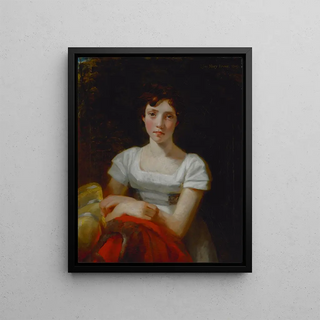Art print | Marie Freer - John Constable


View from behind

Frame (optional)
Marie Freer - John Constable Art print – Captivating introduction
The artwork "Marie Freer - John Constable" is part of an artistic tradition that celebrates the beauty of English landscapes and the finesse of portraits. This painting, imbued with delicacy, demonstrates John Constable's skill in capturing not only the light and colors of nature but also human emotions. By examining this creation, one discovers a universe where nature and humanity coexist harmoniously, revealing a depth that invites contemplation. The depiction of Marie Freer, an iconic figure, is both a tribute to feminine beauty and an exploration of human relationships within a pastoral landscape.
Style and uniqueness of the work
Constable's work stands out for its realistic approach and its ability to evoke sensations through painting. In "Marie Freer," the artist's technique is expressed through lively and expressive brushstrokes, which give a vivid texture to the surrounding natural elements. Shades of green, blue, and yellow intertwine to create an atmosphere that is both serene and dynamic, capturing the very essence of the English countryside. Light plays a central role, illuminating Marie's face with an almost ethereal softness, while casting delicate shadows that add depth to the composition. This art print does not merely depict a figure; it tells a story, that of a woman rooted in her environment, both vulnerable and strong.
The artist and his influence
John Constable, a key figure in British Romantic landscape art, redefined how nature was perceived and represented in art. His work is marked by an unceasing quest for visual truth, seeking to capture not only the appearance of things but also their essence. Constable influenced many artists, both contemporaries and successors, by demonstrating the importance of direct observation and emotion in artistic creation. His approach paved the way for movements such as Impressionism, where light and color take a prominent place. Through "Marie Freer," the artist offers not just a representation but also a reflection on the relationship between man and his environment, a theme

Matte finish

View from behind

Frame (optional)
Marie Freer - John Constable Art print – Captivating introduction
The artwork "Marie Freer - John Constable" is part of an artistic tradition that celebrates the beauty of English landscapes and the finesse of portraits. This painting, imbued with delicacy, demonstrates John Constable's skill in capturing not only the light and colors of nature but also human emotions. By examining this creation, one discovers a universe where nature and humanity coexist harmoniously, revealing a depth that invites contemplation. The depiction of Marie Freer, an iconic figure, is both a tribute to feminine beauty and an exploration of human relationships within a pastoral landscape.
Style and uniqueness of the work
Constable's work stands out for its realistic approach and its ability to evoke sensations through painting. In "Marie Freer," the artist's technique is expressed through lively and expressive brushstrokes, which give a vivid texture to the surrounding natural elements. Shades of green, blue, and yellow intertwine to create an atmosphere that is both serene and dynamic, capturing the very essence of the English countryside. Light plays a central role, illuminating Marie's face with an almost ethereal softness, while casting delicate shadows that add depth to the composition. This art print does not merely depict a figure; it tells a story, that of a woman rooted in her environment, both vulnerable and strong.
The artist and his influence
John Constable, a key figure in British Romantic landscape art, redefined how nature was perceived and represented in art. His work is marked by an unceasing quest for visual truth, seeking to capture not only the appearance of things but also their essence. Constable influenced many artists, both contemporaries and successors, by demonstrating the importance of direct observation and emotion in artistic creation. His approach paved the way for movements such as Impressionism, where light and color take a prominent place. Through "Marie Freer," the artist offers not just a representation but also a reflection on the relationship between man and his environment, a theme






